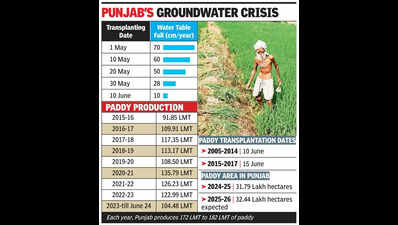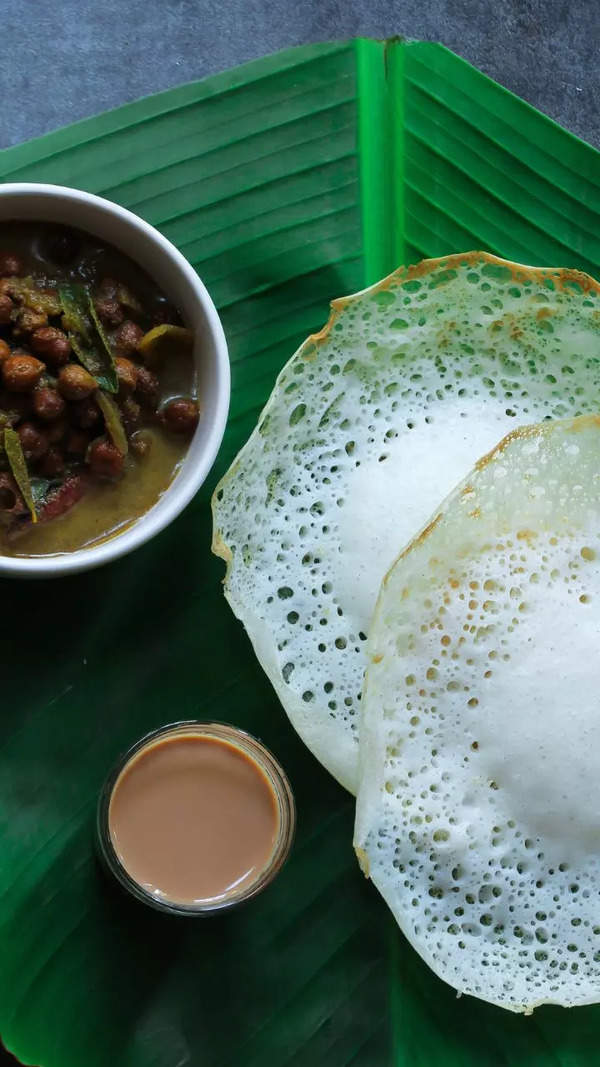- News
- City News
- chandigarh News
- Early paddy transplantation may impact Punjab's groundwater reserves: Experts
Trending
Early paddy transplantation may impact Punjab's groundwater reserves: Experts
Patiala: As chief minister Bhagwant Mann has announced that paddy transplantation in Punjab would begin on June 1, earlier than last year's start date of June 11, experts in the field cautioned against the move and cited how the delay in paddy sowing can significantly help Punjab curb the depletion of its groundwater reserves. The decision came after years of attempts to curb groundwater depletion by delaying paddy sowing.
In 2008, the state govt issued an ordinance not to allow the transplantation of rice before June 10. Later in 2015, the date of rice transplanting was delayed to June 15. In 2018, the transplanting date of paddy was further delayed to June 20, but in 2019, the transplanting time was advanced to June 13.
Providing insights into the issue, former PAU additional director Gurdev Singh Heera said that initially, during the 1970s, paddy transplanting used to start with the onset of monsoon rains, around June 30. However, over the years, the transplanting date was gradually advanced to as early as May 20 due to various factors like labour availability, electricity supply, and the adoption of long-duration varieties. This advancement had a devastating effect on the groundwater table, leading to a substantial fall.
Heera conducted a study that clearly shows that delaying rice transplanting can significantly reduce the rate of groundwater depletion. For instance, when transplanting was delayed to June 10, the average water table fall in Punjab reduced from 54 cm/year (1998-2005) to 27 cm/year (2005-2015). The impact was particularly significant in districts like Ropar, Moga, Amritsar, Jalandhar, Tarn Taran, Fazilka, Mohali, and Kapurthala, where the arrest of water table fall ranged from 44 to 79 cm/year.
"The delaying of paddy sowing can significantly contribute to saving Punjab's rapidly depleting groundwater reserves. Coupled with other remedial measures like crop diversification, reviving old river pathways, and rainwater harvesting, this approach can help ensure the sustainability of Punjab's groundwater resources, which are crucial for the state's agricultural productivity and food security," he added.
Punjab has been a major contributor of wheat and rice to India's central foodgrain pool since the Green Revolution began. The state's contribution to the central pool in 2022-23 stood at 46.24% for wheat and 21.43% for rice, although previously these figures were substantially higher at 55% for wheat and 42% for rice. The substantial and sustained contribution of foodgrains from Punjab has resulted in significant depletion of its groundwater resources. The irrigation coverage expanded dramatically from 54% in the 1960s (22% via tubewells and 32% through canals) to current levels of 100% (72% through tubewells and 28% via canals).
Punjab chief engineer (Irrigation) Sher Singh, said, "Earlier, 70 percent of water from Punjab's share of water from the dams was being supplied to the farmers for irrigation, but this time 100 percent of supply will be done. This time all the farmers having canal water supply will get their share."
No recommendations by PAU for advance sowing
Punjab Agriculture University vice-chancellor Satbir Singh Gosal said that there are no recommendations from the university for advancing the paddy sowing. He said, "The PAU recommends the paddy transplantation after June 10, after the state assembly passed 'Preservation of Subsoil Water Act in 2009. The state govt this time has advanced paddy transplantation, which will be divided in four zones with priority to be given to districts having sufficient canal water supply. The decision aimed to avoid complications for farmers in selling their paddy harvest due to high moisture content in Oct. The farmers sowing short duration paddy varieties, especially PR 126, before July 15 will not face moisture problem but due to rising area under spring maize or summer maize which is sown in March and harvested in July is creating issue as farmers get delay beyond July 15 in paddy sowing."
#designer
**BOX:**
Transplanting Date | Water Table Fall (cm/year)
---|---
1 May | 70
10 May | 60
20 May | 50
30 May | 28
10 June | 10
Paddy Transplantation Dates:
Before 10 June = 1989-2004;
10 June = 2005-2014;
15 June = 2015-2017
Paddy Area in Punjab:
2024-25: 31.79 Lakh hectares
2025-26: 32.44 Lakh hectares expected
**BOX:**
**Power Subsidy for Agriculture Pumpset:**
2005-06: Rs 1385.92 crores
2006-07: Rs 1522.61 crores
2007-08: Rs 2284.37 crores
2008-09: Rs 2264.92 crores
2009-10: Rs 2804.99 crores
2010-11: Rs 2702.87 crores
2011-12: Rs 3879.95 crores
2012-13: Rs 4787.07 crores
2013-14: Rs 4778.13 crores
2014-15: Rs 4454.54 crores
2015-16: Rs 4709.91 crores
2016-17: Rs 5196.77 crores
2017-18: Rs 5976.82 crores
2018-19: Rs 6256.09 crores
2019-20: Rs 6060.27 crores
2020-21: Rs 7180.54 crores
2021-22: Rs 6745.06 crores
2022-23: Rs 9063.79 crores
2023-24: Rs 8881 crores
**BOX:**
Each year, Punjab produces 172 LMT to 182 LMT of paddy
**Rice:**
2009-10: 87.64 LMT
2010-11: 84.48 LMT
2011-12: 74.70 LMT
2012-13: 83.54 LMT
2013-14: 80.73 LMT
2014-15: 77.56 LMT
2015-16: 91.85 LMT
2016-17: 109.91 LMT
2017-18: 117.35 LMT
2018-19: 113.17 LMT
2019-20: 108.50 LMT
2020-21: 135.79 LMT
2021-22: 126.23 LMT
2022-23: 122.99 LMT
2023-till June 24: 104.48 LMT
**Total: 1518.92 LMT**
MSID:: 119936048 413 |
End of Article
FOLLOW US ON SOCIAL MEDIA











